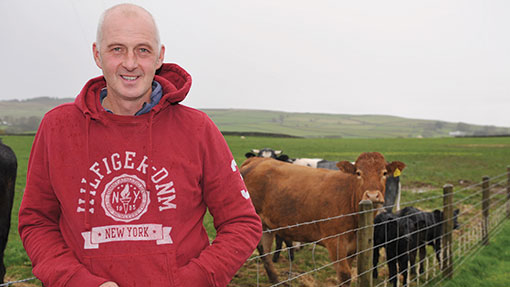Smaller’s better for suckler cows, research shows

Size may be a better measure of suckler cow efficiency than current industry standards. Farmers Weekly takes a closer look.
Smaller suckler cows have been shown to be the most efficient in a new study analysing the weights of cows and their weaned calves.
Cow size, which has steadily increased in recent years, is often overlooked as a measure of efficiency to compare the performance of different suckler herds. Instead, the emphasis has been on industry-standard figures such as calving spread and percentage of calves weaned.
See also: Expert advice on suckler cow winter management
A new study involving three Farming Connect demonstration farms in Wales has shown that suckler cows of a lower weight are, in general, more efficient at producing calf weight a unit of cow weight.
“This will be achieved at lower cost due to the high cost of maintaining bigger cows,” says beef specialist Ian Pritchard, who is overseeing the trial. “In a 12-month period, 75% of feed consumed is used for maintenance by the animal and this is directly related to cow size.”
At one of the trial farms, the 12 heaviest cows with an average weight of 678kg had an efficiency factor of 44.5% compared with 60.5% in the 12 lightest cows averaging 521kg. By replacing the larger cows with smaller ones it would be possible to carry 15% more, says Mr Pritchard of SAC Consulting.
“Why keep big cows unless it is proven that they are more efficient on your farm?” he questions.
The cow with the best efficiency was a third-calver weighing 548kg with a weaned calf at 395kg. She achieved an efficiency factor of 72%. The worst performing, at 29%, was an eight-year-old cow weighing 634kg with a weaned calf of 183kg. Often farms have a range of 250kg in cow weights.
Stay Connected
Farming Connect is a Wales-wide service funded by the Rural Development Programme and the Welsh government. As part of an ongoing new series Farmers Weekly will be visiting a different Farming Connect demonstration farm regularly to find out what projects have been undertaken and how performance is benefiting.
Mr Pritchard says the trial results should encourage suckler producers to appraise their own systems and to take an objective view of their herds.
“The role of cows is not to produce prime carcasses, but to reproduce in an efficient manner, that is to produce a calf every year.”
Although individual animal performance is important, the reason for a number of cows not producing a calf must be investigated, he adds.
The size of the cow needs to match environmental resources, otherwise fertility and calf performance will be compromised, says Mr Pritchard.
Condition score
The trial also demonstrated that suckler cows with a lower condition score at weaning tended to show higher efficiency.
Cow condition scores and cow and calf liveweights were collected at weaning following the 2012 and 2013 calving seasons. Cows with condition scores of 1.5 and 2.0 achieved an efficiency factor of 57% compared with 47% in cows at condition score 3.0.
“This shows that the cows with a lower condition score at weaning can be the efficient producers,” says Mr Pritchard. “However good management of these cows post-weaning is necessary so that they continue to reproduce in the herd in an efficient manner.”
The trial, which is ongoing, will also monitor if any advantage might be lost through an efficient cow failing to get back in calf.
Mr Pritchard advises producers to use cow and calf data to calculate efficiency every year, adjusting for age differences at weaning if the calving period is extended.
One of the trial farms, Hafod-y-Maidd, near Corwen, Conwy, introduced Luing cattle into the suckler herd last year with a view to improving efficiency.
The farmers, Iwan and Eleanor Davies, believed this native beef breed would be an ideal match for the environment at Hafod-y-Maidd.
“We have been asked several times why Luings and not Welsh Blacks and the answer to that was that we liked the breed’s classification scheme. It is well established and emphasises the characteristics of the dam more than any other breed,” says Mr Davies.
“The Luings will be well suited to grazing the marginal land and this will free up more land to fatten lambs. We hope this will enable us to fatten 75% of our lambs by the end of October instead of the current 50%.”
Mr Pritchard says it is essential for the farming industry to pay heed to advice derived from Farming Connect demonstration farms and for farmers to encompass changes suited to their systems.
“Costings on livestock farms still show that it is difficult to make profit without subsidies, but there are steps that farmers can take to make sure that productivity and financial output can increase,” he says.
